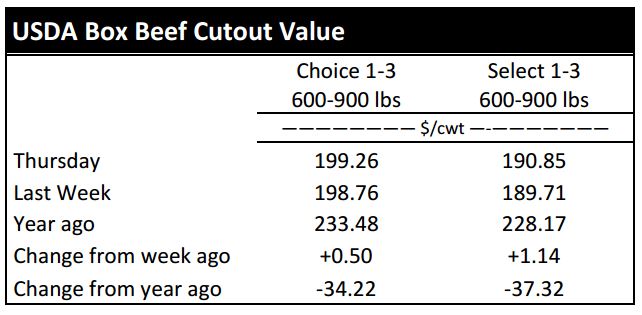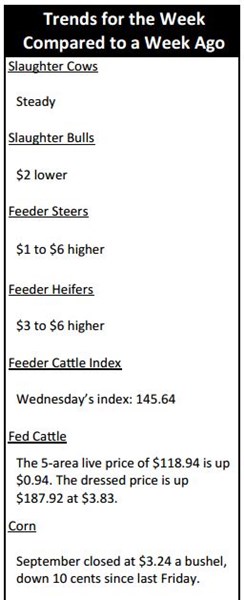Market Highlights: Questions About Cattle Prices
By: Andrew P. Griffith, University of Tennessee
FED CATTLE: Fed cattle traded $2 higher compared to a week ago on a live basis. Live prices were mainly $118 while dressed trade was mainly $187-$188. The 5-area weighted average prices thru Thursday were $118.94 live, up $0.94 from last week and $187.92 dressed, up $3.83 from a week ago. A year ago prices were $148.48 live and $233.75 dressed.
It is almost certain that finished cattle have put in their summer lows as prices have found support. Cattle feeders could be happier with higher prices, but they will suffice with the stronger prices experienced the past couple of weeks. Based on seasonal prices, fed cattle prices increase an average from 5 to 6 percent from summer low to fall price peak.
A 5 percent price increase would put finished cattle near $122 this fall. However, December live cattle futures are trading near $115 which insinuates lower prices from now until the end of the year. One truth about futures markets is that they are wrong! In this case, futures appear to be greatly undervaluing finished cattle in the fourth quarter.
BEEF CUTOUT: At midday Friday, the Choice cutout was $198.95 down $0.31 from Thursday and up $1.04 from last Friday. The Select cutout was $190.45 down $0.40 from Thursday and up $0.59 from last Friday. The Choice Select spread was $8.50 compared to $8.05 a week ago.
Packers are patiently or potentially impatiently waiting on Labor Day sales to support wholesale beef prices. The Choice and Select cutout prices have had little to know support since most major purchases were made for Independence Day. Since the middle of June, the Choice cutout has declined about $27 per hundredweight. Packers have still been able to make money, but negative price movement always captures attention.
Chuck and round primal prices have struggled most of the year and the summer months have been even less kind. Middle meats have been supportive of cutout prices and packers hope middle meats provide a surge of energy to prices leading up to Labor Day. Another product that is helping the packers is fresh 50 percent lean beef. Lean trim has found a way to hold near the $90 per hundredweight level for a couple of months which greatly supports packer profits. Though packers are looking for a positive price movement the next few weeks, the fall of the year will be challenging as more meat hits the market.
OUTLOOK: Nearby feeder cattle futures have increased more than $14 since July 21st with more than $9 of that improvement being witnessed this week. The stronger futures market prices this week translated to higher prices in cash calf and feeder cattle markets. Based on Tennessee weekly auction market averages, steers were $1 to $6 higher compared to last week while heifers were $3 to $6 higher than a week ago. The price improvement was also evident in load lot sales that took place in the state this week. Compared to last month, prices on video sales were mainly $3 to $6 higher depending on weight class.
At first glance, a $3 to $6 increase on load lots being marketing through a video platform does not look like a big jump. However, August feeder cattle futures were trading in the $143 to $144 range at the beginning of July before the contract made a new contract low on July 21st. August feeder cattle futures were trading north of $149 which translates well for the increases witnessed on August video sales in the state. The back half of summer is usually a strong period for feeder cattle, but many producers are already looking toward the fall marketing time period.
The questions abound if prices are going to continue to strengthen or if they will falter heading into the fall of the year. The answer is different depending on the weight class and management provided to those animals.
Yearling cattle prices will likely remain strong the next few weeks, but will begin to taper off as the market moves closer to the fall. However, prices for these animals will likely remain relatively strong compared to calves coming straight off the cow this fall.
Producers wanting to market calves at weaning should look to move those animals earlier rather than later. Calf prices this fall are expected to decline, and they could do it to the tune of mid $120s in Tennessee for 550 pound steers. These prices probably sound devastating to some producers, and if they do sound terrible then producers may want to think about changing management and marketing practices to capture additional value.
ASK ANDREW, TN THINK TANK: A question was posed at the Tri-State Beef Conference yesterday to Dr. Justin Rhinehart pertaining to artificially inseminating the cattle herd starting the first of June. The question was posed from a production standpoint as it relates to successfully breeding cows in the heat of the summer and then not calving until after the coldest parts of winter. The production question is a great question, but it made me think about marketing and production costs. One reason for having a true spring calving season is to reduce feed costs relative to feeding lactating cows through the winter. From the marketing standpoint, these animals will probably be weaned in October which does not lend itself to selling the calves at weaning. However, a preconditioning and backgrounding program could easily be used to market these animals at a time when prices are moving in an advantageous direction for the weight class.
Please send questions and comments to agriff14@utk.edu or send a letter to Andrew P. Griffith, University of Tennessee, 314B Morgan Hall, 2621 Morgan Circle, Knoxville, TN 37996.
FRIDAY’S FUTURES MARKET CLOSING PRICES: Friday’s closing prices were as follows: Live/fed cattle –August $117.68 1.35; October $115.53 0.75; December $115.68 0.80; Feeder cattle - August $149.65 2.08; September $147.20 1.98; October $143.88 0.90; November $140.73 0.78; September corn closed at $3.24 up $0.04 from Thursday.











